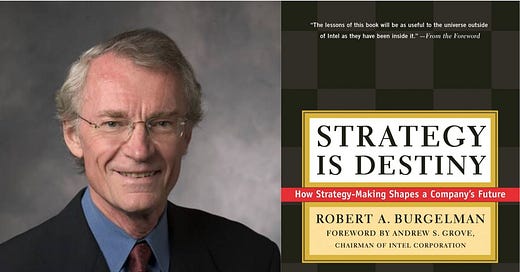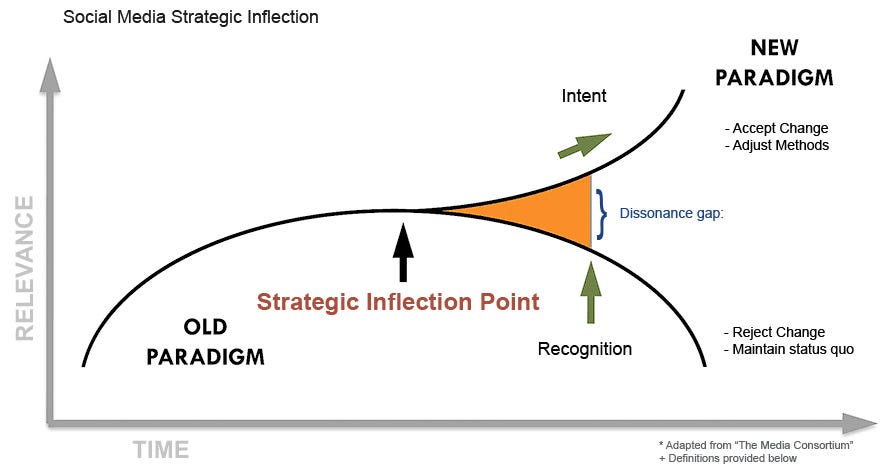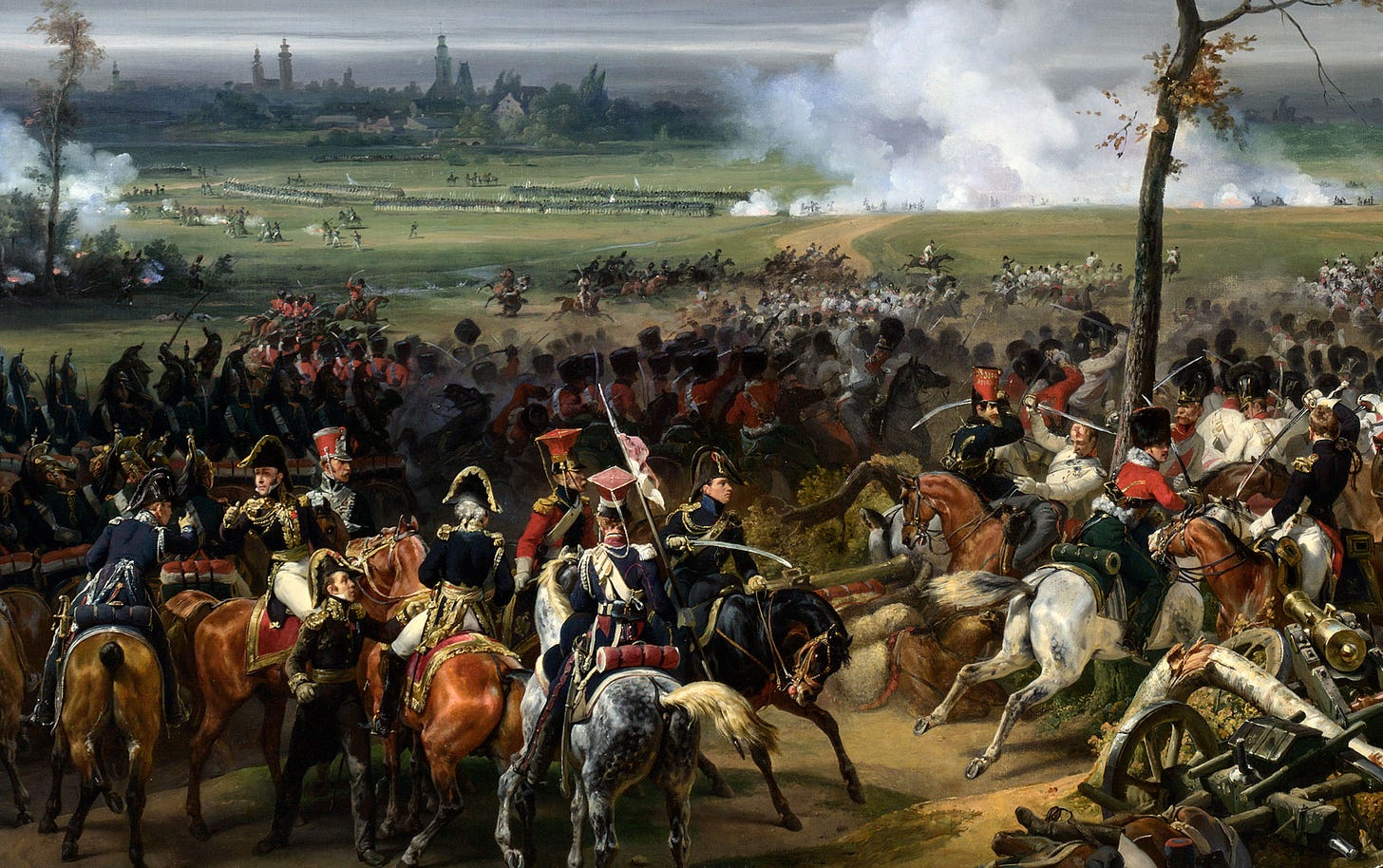What Stanford teaches about Product Strategy
+ Professor Burgelman's Strategy Diamond Model + What’s common between French Military Commander Napolean Bonaparte and Product Strategy?
What’s common between French Military Commander Napolean Bonaparte and Product Strategy?
What does a Stanford Professor want to warn you about, when it comes to Product Strategy?
Today we shall find out.
Last week at Stanford Graduate School of Business, I had the opportunity to attend some classes from Professor Robert A. Burgelman (The Edmund W. Littlefield Professor of Management) and understand his frameworks and approach to business and product strategy. What made him more interesting that others is his child-like curiosity and approach to strategy.
Often we get drowned in slides and documents that use interesting frameworks to get to a strategy, but what benefit is a big slide deck or a long document that does not eventually help you win or learn in the market?
Professor. Burgelman first defines strategy as:
Strategy is the thinking that drives action to be successful in competition and collaboration.
What I liked about this definition is that it emphasizes on winning in market, but also mentions two important components that are often missing in other definitions or frameworks of strategy:
i) thinking that drives action (i.e Execution aspects)
ii) collaboration (i.e working with others)
A lot of product strategy approaches in organizations assume that of-course Execution will be great, and of-course we will collaborate well with each other and ecosystem, we just need a great strategy. But execution and collaboration are exactly the two things that are missing in strategy frameworks and often the biggest reason strategy fails.
Tired of messy design boards and endless requirements?
Wireframing for Everyone is your path to clarity and efficiency. Crafted by Balsamiq’s UX experts: Michael Angeles, Leon Barnard, and Billy Carlson, and brought to you by A Book Apart—this one's a game-changer for anyone in product.
Further he simplifies it one more level by saying:
As organizations, we don’t want to disappear in few years or decades. To be built for long run, you need you control your destiny.
Those who have a strategy, may and can control their destiny.
Those who do not - Fate decides their destiny.
Humans are by nature short-term thinkers when compared to the potential lifetime of an organization. Organizations can exist for 10 years or up-to 200 years, but humans optimize for next 1 year or 5 years at maximum (and more blurry it gets). A lot of them allow Fate to decide their destiny.
Take for instance, only 10% of companies in Fortune 500 list of 1955 exist today. All these organizations claimed to have a good strategy, good team and a leader who believed in themselves and the team. But fate does take over often.
It’s reasonable to assume that when the Fortune 500 list is released 60 years from now in 2079, almost all of today’s Fortune 500 companies will no longer exist as currently configured, having been replaced by new companies in new, emerging industries, and for that we should be extremely thankful. (Source)
But Professor Burgelman doesn’t stop there. He mentioned three more things which I will recommend all readers of Productify to include in their strategy process:
How to stop your strategy from failing, and take steps ahead of time? (How to predict upcoming failure of a business model)
How to go about execution of your strategy? (learnings from how Napolean fought battles)
Assess the Strategic Diamond Framework
Here’s how Stanford students are taught to go about above super critical questions:
How to predict upcoming failure and take corrective steps?
First, you need to understand the concept of strategic inflection points.
The strategic turning point: the moment when you recognize that if we persist with our current approach, we are headed towards obsolescence and failure.
Origins of the strategic turning point concept. The notion of a strategic turning point gained prominence in the early 1990s through the efforts of Andy Grove, then serving as the CEO of Intel.
Instances of strategic turning points, where companies have faltered in adapting effectively, encompass:
Kodak: Lacking agility in embracing digital camera technology.
Blockbuster: Failing to adapt its business model to address online competitors.
Blackberry: Ineffective response to the emergence of smartphone alternatives.
Professor Burgelman suggests that leaders should continue to ask below questions to their teams and their executive teams to stay ahead of inflection points and take corrective actions:
Do we know what it takes to win? (Plans)
Do we have what it takes to win? (Team, Culture, Skillsets, Infra)
Are we doing what we’re saying? (Execution)
There is 100% chance that the reason for lack of strategic success for a company or a business model lies in one of the three buckets above.
Let us take Kodak for example. They probably failed to ask below and do some of the things below it:
Do we know what it takes to win?
Invested in deep market research to understand emerging trends and technologies, such as digital photography.
Kept a close eye on consumer preferences and adapted their product development accordingly.
Collaborated with industry experts to gain insights into the future of photography.
Do we have what it takes to win?
Culturally, are we ready to embrace a new business model at the risk of losing revenues in current business model?
Evaluated their internal capabilities, including their workforce's skills and their technological infrastructure.
Actively recruited talent with expertise in digital imaging and related fields.
Considered partnerships or acquisitions to strengthen their position in the digital photography market.
Are we doing what we’re saying?
Implemented a strategic plan that aligned with their understanding of the industry and their internal capabilities.
Continuously monitored progress and adjusted their strategies as needed.
Encouraged a culture of innovation and adaptability within the organization.
I like to simply put it as : do not fall in love with your revenues and business models, they look good today but if data suggests then 90% of companies of today will not exist in another 70-80 years, so you’re bound to be disrupted.
Instead, find out: What else is out there that is complementary to your core, but is also the next bet to sustain and grow your revenues - invest in bets that may not make sense today.
How to execute your strategy?
Lastly, Professor Burgelman (who often loves to quote history, poems, great writers) to drive home the point of strategy. Let us read a story:
Napoleon, a name synonymous with strategy, reshaped the very essence of warfare, leaving an indelible mark on the annals of combat.
Among his myriad strategies, one stands out as a captivating enigma: his approach to battle itself.
In the whispers of history, Napoleon is credited with uttering those immortal words, "On s'engage et puis ... on voit," which, when translated, echo, "Engage, and then we shall see."
Napoleon was no stranger to meticulous preparation. He delved deep into the minds of his adversaries, deciphered the lay of the land, and meticulously crafted his battle blueprints.
Yet, he held a profound understanding that in the theater of war, the unexpected reigned supreme. In the blink of an eye, the tides could shift, and victory could morph into defeat. Adaptation was the key to survival.
For Napoleon, the heartbeat of warfare was movement. In his audacious Italian campaign of the 1790s, he orchestrated a symphony of troop maneuvers, orchestrating a relentless dance across the nation's canvas. It was a breathtaking spectacle that consistently outmaneuvered the Austrians and their Piedmontese allies, ensuring that battles unfolded precisely when and where he desired.
Innovation coursed through his veins. He urged the French military to wield field guns lighter by a third than their British counterparts. This technological leap allowed for the swift repositioning of artillery across the battlefield, maximizing their deadly impact.
Yet, the crux of Napoleon's brilliance lay in his army's organization. He shattered tradition, dividing his forces into independent, nimble corps.
Each corps possessed the autonomy to march, fight, and adapt on its own, transcending the limitations of a lumbering monolith. Guided by gifted corps commanders, these divisions became the backbone of the French army, a formidable force on the battlefield.
In the grand tapestry of Napoleon's military genius, a resounding message emerges: meticulous planning paired with the ability to pivot swiftly. His winning formula was clear—to research and strategize exhaustively, yet remain agile enough to change course in the face of uncertainty. It's a lesson in warfare that echoes through the ages, an eternal testament to the art of the unexpected.
Above story is about Napolean, but it is more about teams, nimbelness and the message - only those who engage - find out what it means to win.
Strategy is nothing if it is sitting in a document - but it is everything if you engage in the market - find where you’re going right or wrong and then make the move to pivot or scale.
So, next time someone asks you to come up with a strategy, always keep in mind to "On s'engage et puis ... on voit,"
I know a lot of Productify readers love Strategy frameworks, and I shall not disappoint.
You can find all strategy frameworks you need here.
Professor Burgelman’s Strategic Diamond Model
There are four aspects to Professor Burgelman’s strategic diamond model published as part of *Burgelman, R.A. and Grove, A.S. “Strategic dissonance.” California Management Review, 1996
Due to copyright reasons, I will not be able to share the complete publication, but here are 4 aspects for you to consider while writing your strategy as dictated by Strategic Diamon Model:
What We Say (Corporate Strategy)
What We Do (Strategic Action)
What it takes to win (Basis of competitive advantage in industry)
What we’ve got (Distinctive competence of the firm)
You could answer above four in a document or in a deck or put them in a matrix - often product managers and leaders get stuck in formats - but forget to ask which questions to answer.
What We Say (Corporate Strategy): This represents the formalized plans, goals, and objectives articulated by a company to guide its actions and decision-making. It includes the mission, vision, and strategic direction a company communicates to stakeholders, outlining its intended path and purpose.
What We Do (Strategic Action): This signifies the actual execution of a company's corporate strategy. It involves the tangible steps, initiatives, and activities undertaken by the organization to achieve its stated goals. Effective strategic actions are aligned with the stated strategy and are essential for its successful implementation.
What it takes to win (Basis of Competitive Advantage in Industry): This refers to the key factors or advantages that enable a company to outperform its competitors in the industry. It encompasses elements like cost leadership, innovation, differentiation, or unique capabilities that give the company a competitive edge and allow it to thrive in its chosen market.
What We’ve Got (Distinctive Competence of the Firm): This represents the unique strengths, skills, resources, and capabilities that set a company apart from its rivals. It includes the internal assets and expertise that a company leverages to create value and achieve its strategic objectives. Identifying and utilizing distinctive competencies is crucial for sustained competitive advantage.












